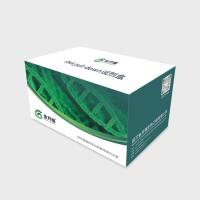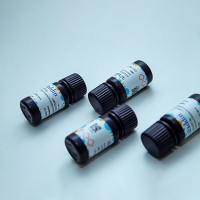Detection of Protein‐Protein Interactions by Coprecipitation
互联网
- Abstract
- Table of Contents
- Materials
- Figures
- Literature Cited
Abstract
Coprecipitation of proteins from whole?cell extracts is a valuable approach to testing for physical interactions between proteins of interest. When a precipitating antibody is used, this method is referred to as co?immunoprecipitation. Coprecipitation can be used to study interactions between known proteins and as a means of identifying components of a complex. This unit describes basic approaches to immunoprecipitating tagged proteins from whole?cell extracts. The extract is prepared under nondenaturing conditions, the protein of interest is precipitated, and the precipitate is tested for a second specifically associated protein. The approach can be used for native or epitope?tagged proteins for which antibodies are available, or for recombinant proteins that bind with high affinity to a molecule that can be coupled to a solid?phase matrix. An associated protein is detected by separating the precipitated proteins by SDS?PAGE and immunoblotting with a second antibody that recognizes the putative associated protein.
Keywords: co?immunoprecipitation; immunoprecipitation; protein interactions; protein tags; antibody; immunoblot
Table of Contents
- Strategic Planning
- Basic Protocol 1: Coprecipitating Proteins with Protein A/G–Sepharose
- Alternate Protocol 1: Coprecipitating a GST Fusion Protein
- Reagents and Solutions
- Commentary
- Literature Cited
- Figures
Materials
Basic Protocol 1: Coprecipitating Proteins with Protein A/G–Sepharose
Materials
Alternate Protocol 1: Coprecipitating a GST Fusion Protein
|
Figures
-
Figure 5.25.1 Flow chart for the coprecipitation of two proteins that have been differentially tagged and introduced into the host organism. Ig h and Ig l, immunoglobulin heavy and light chains; NT, no tag. View Image
Videos
Literature Cited
| Auerbach, D., Galeuchet‐Schenk, B., Hottiger, M.O., and Stagliar, I. 2002. Genetic approaches to the identification of interactions between membrane proteins in yeast. J. Recept. Signal Transduct. Res. 22:471‐481. | |
| BioSupplyNet Source Book. 2005. Cold Spring Harbor Laboratory Press, Cold Spring Harbor, N.Y. | |
| Bornhorst, J.A. and Falke, J.J. 2000. Purification of proteins using polyhistidine affinity tags. Methods Enzymol. 326:245‐254. | |
| Coligan, J.E., Kruisbeck, A.M., Margulies, D.H., Shevach, E.H., and Strober, W. 2006. Current Protocols in Immunology. John Wiley & Sons, New York. | |
| Feng, Y., Song, L.‐Y., Kincaid, E., Mahanty, S.K., and Elion, E.A. 1998. Functional binding between Gβ and the LIM domain of Ste5 is required to activate the MEKK Ste11. Curr. Biol. 8:267‐278. | |
| Field, J., Nikawa, J., Broek, D., MacDonald, B., Rodgers, L., Wilson, I.A., Lerner, R.A., and Wigler, M. 1988. Purification of RAS‐responsive adenylyl cyclase complex from Saccharomyces cerevisiae by use of an epitope addition method. Mol. Cell. Biol. 8:2159‐2165. | |
| Gavin, A. and Superti‐Furga, G. 2003. Protein complexes and proteome organization from yeast to man. Curr. Opin. Chem. Biol. 7:21‐27. | |
| Harlow, E. and Lane, D. 1988. Antibodies: A Laboratory Manual. Cold Spring Harbor Laboratory Press, Cold Spring Harbor, N.Y. | |
| Harlow, E. and Lane, D. 1998. Using Antibodies: A Laboratory Manual. Cold Spring Harbor Laboratory Press, Cold Spring Harbor, N.Y. | |
| Knappik, A. and Pluckthun, A. 1994. An improved affinity tag based on the FLAG peptide for the detection and purification of recombinant antibody fragments. Biotechniques 17:754‐61. | |
| Kolodziej, P.A. and Young, R.A. 1991. Epitope tagging and protein surveillance. Methods Enzymol. 194:508‐519. | |
| Phizicky, E.M. and Fields, S. 1995. Protein‐protein interactions:Methods for detection and analysis. Microbiol. Rev. 59:94‐123. | |
| Puig, O., Caspary, F., Rigaut, G., Rutz, B., Bouveret, E., Bragado‐Nilsson, E., Wilm, M., and Seraphin, B. 2001. The tandem affinity purification (TAP) method: A general procedure of protein complex purification. Methods 24:218‐229. | |
| Skerra, A. and Schmidt, T.G.M. 2005. Use of the Strep‐tag and streptavidin for detection and purification of recombinant proteins. Methods Enzymol. 326:271‐304. | |
| Toby, G.G. and Golemis, E.A. 2001. Using the yeast interaction trap and other two‐hybrid‐based approaches to study protein‐protein interactions. Methods 24:201‐217. | |
| Tyers, M., Tokiwa, G., and Futcher, A.B. 1993. Comparison of the Saccharomyces cerevisiae G1 cyclins: Cln3 may be an upstream activator of Cln1, Cln2, and other cyclins. EMBO J. 11:1773‐1784. | |
| Wang, Y., Chen, W., Simpson, D.M., and Elion, E.A. 2005. Cdc24 regulates nuclear shuttling and recruitment of the Ste5 scaffold to a heterotrimeric G protein in Saccharomyces cerevisiae. J. Biol. Chem. 280:1304‐13096. | |
| Witzgall, R., O'Leary, E., and Bonventre, J.V. 1994. A mammalian expression vector for the expression of GAL4 fusion proteins with an epitope tag and histidine tail. Anal. Biochem. 2:291‐298. | |
| Yang, P., Sampson, H.M., and Krause, H.M. 2006. A modified tandem affinity purification strategy identifies cofactors of the Drosophila nuclear receptor dHNF4. Proteomics 6:927‐935. | |
| Key References | |
| BioSupplyNet Source Book. 2005. See above. | |
| Published yearly. Instant access is available on the WWW, at http://www.biosupplynet.com. | |
| Harlow and Lane, 1998. See above. | |
| General discussion of immunoprecipitation techniques and reagents. | |
| Phizicky and Fields, 1995. See above. | |
| General discussion of methodologies for detecting protein‐protein interactions as well as their merits and drawbacks. |






